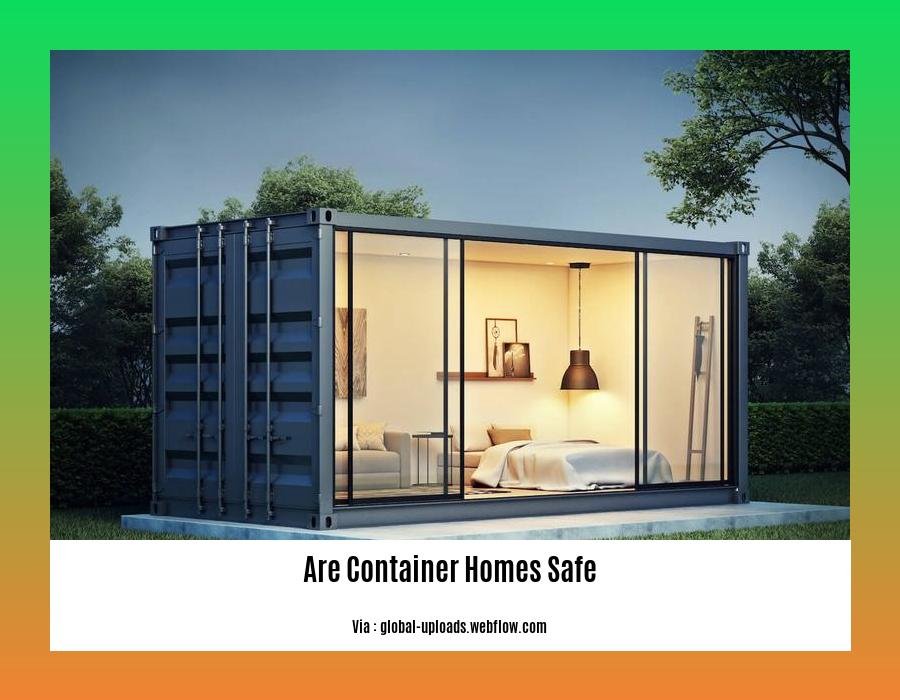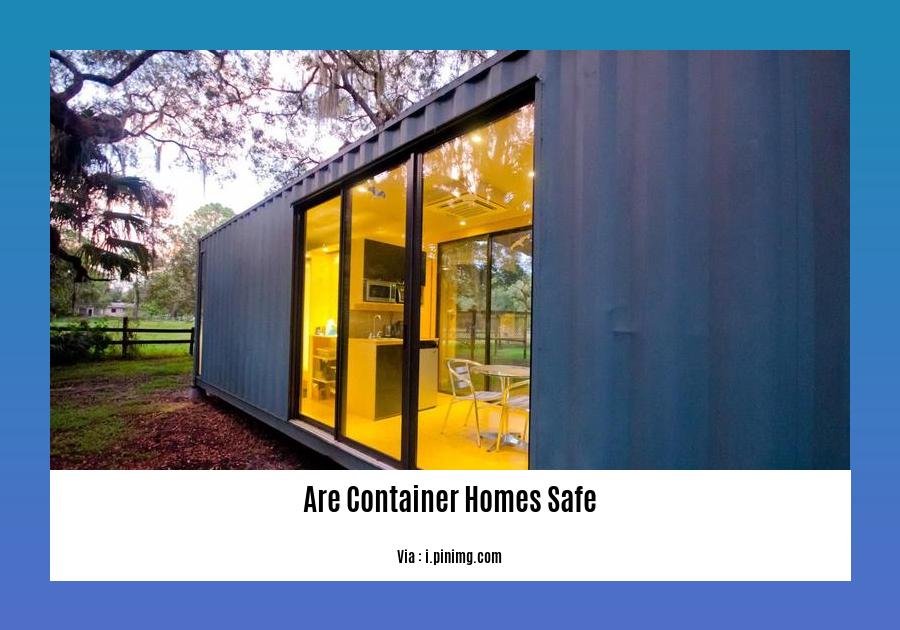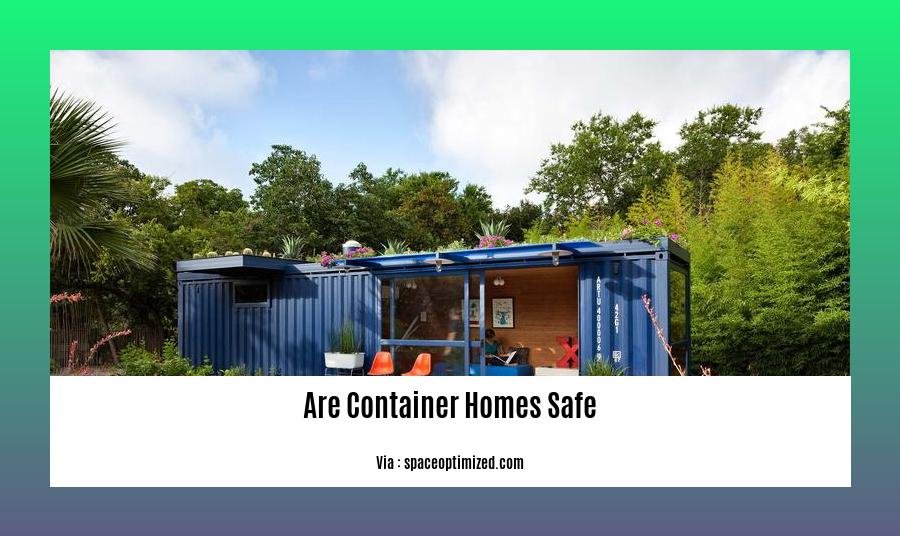Are Container Homes Safe: Unveiling the Truth Behind the Myths and Misconceptions: As modern architecture continues to embrace innovative and environmentally conscious design, the question of safety regarding container homes remains a prominent concern among potential homeowners and skeptics alike. This article aims to dispel common myths and misconceptions surrounding the safety of container homes, delving into the structural integrity, durability, and resilience of these unique structures. Through expert insights and real-life examples, we uncover the truth behind the safety of container homes, providing valuable information for those considering this sustainable and affordable alternative to traditional housing.
Key Takeaways:
- Safety of container homes lies in proper precautions taken during construction to address potential hazards.
- Structurally equivalent to traditional homes.
- More cost-effective and resource-efficient compared to traditional homes.
Are Container Homes Safe?

Whether you’re mulling over the idea of downsizing, embracing a more sustainable lifestyle, or simply seeking an unconventional living space, container homes might have piqued your curiosity. With their growing popularity, questions about their safety understandably arise. Let’s dive into the realm of container homes – are they truly safe havens or potential hazards?
Safety Unraveled: Delving into the Material Integrity of Container Homes
At the core of container homes’ safety lies the foundation upon which they’re built—shipping containers. These steel behemoths, initially designed to withstand treacherous sea voyages, possess inherent strength and durability. Their robust construction makes them resistant to high winds, earthquakes, and even hurricanes, ensuring they’re not easily swayed by nature’s fury.
Structural Integrity: The Cornerstone of Safe Container Homes
Contrary to popular belief, container homes are not mere metal boxes haphazardly converted into living spaces. They undergo meticulous modifications to meet stringent building codes and safety standards. These homes are engineered to endure the weight of additional stories, ensuring stability and structural integrity. With proper reinforcements and adherence to building regulations, container homes can rival traditional structures in terms of resilience.
Myths and Misconceptions: Dispelling Common Concerns About Container Homes
While container homes continue to gain traction, several misconceptions and unfounded fears persist. Allow me to address some of the most prevalent ones:
- Myth: Container homes are prone to rust and corrosion.
Fact: Modern shipping containers are treated with protective coatings and paints designed to prevent rust and corrosion. Proper maintenance and regular inspections further ensure their longevity.
- Myth: Container homes are susceptible to extreme temperatures.
Fact: With appropriate insulation and climate control systems, container homes can maintain comfortable temperatures, just like traditional homes.
- Myth: Container homes are inherently dangerous and unsafe.
Fact: When constructed by experienced professionals who adhere to building codes and safety regulations, container homes are as safe as conventional dwellings.
Unveiling the Advantages of Container Homes: A Sustainable and Resilient Choice
Apart from safety concerns, container homes offer several compelling advantages:
-
Environmental Sustainability: Container homes repurpose used shipping containers, reducing waste and minimizing environmental impact. They’re a testament to sustainable architecture.
-
Cost-Effectiveness: Utilizing shipping containers as building blocks significantly reduces construction costs, making container homes an affordable housing option.
-
Construction Speed: Container homes can be constructed remarkably quickly, often in a matter of weeks, compared to traditional homes, which can take months or even years.
-
Design Flexibility: Container homes offer versatile design possibilities. They can be customized to suit personal preferences, functional needs, and architectural styles.
Making an Informed Decision: Weighing the Pros and Cons of Container Homes
Pros:
- Durable and structurally sound
- Resistant to natural calamities
- Cost-effective and time-efficient to construct
- Eco-friendly and sustainable housing option
- Versatile design possibilities
Cons:
- Potential for insulation challenges
- May require specialized contractors with container home building experience
- Limited space compared to traditional homes
- May face difficulties obtaining financing from traditional lenders
Ensuring Safety in Container Homes: Essential Considerations
To ensure the safety of container homes, several key factors must be considered during the construction process:
-
Structural Integrity: Adherence to building codes and engineering standards is paramount.
-
Insulation and Climate Control: Proper insulation and climate control systems are crucial for maintaining comfortable temperatures.
-
Fire Safety: Fire-resistant materials and proper electrical installations minimize fire hazards.
-
Weatherproofing: Ensuring weatherproofing prevents leaks, water damage, and structural issues.
In conclusion, container homes are safe and viable housing options when constructed by experienced professionals who adhere to building codes and safety regulations. They offer numerous advantages, including environmental sustainability, cost-effectiveness, and design flexibility. By dispelling common misconceptions, we can embrace the safety and benefits of container homes, redefining modern living spaces and contributing to a more sustainable future.
-
Chilling nights will become delightful with precisely installed gas fireplaces. Learn more about adding a gas fireplace to an existing home.
-
Adding a home security system brings peace to your mind. Get to know more about the advantages of a home security system.
-
Having an elite siding can boost your home’s appearance and value. Explore various affordable house siding options to find the best fit for you.
-
The cost dilemma between traditional construction and prefabrication can be puzzling. Find out are prefabricated homes cheaper to make an informed choice.
-
Dreaming of a beachside vacation? Discover the most extravagant 5-star hotels in Florida on the beach for an unforgettable experience.
-
Pakistan’s natural beauty is breathtaking. Explore the 50 most beautiful places in Pakistan that will sweep you off your feet.
-
Customize your lighting with dimmable LED strip lights. Explore are all LED strip lights dimmable to find the right ones for your needs.
Evaluating the Structural Integrity of Container Homes: Ensuring Code Compliance, Proper Engineering, and Regular Maintenance
In the realm of container living, safety is paramount. As an experienced construction professional and former resident of a container home, I delved into the structural integrity of these innovative dwellings to bring you the truth behind the misconceptions.
Key Takeaways:
- Structural Integrity: Container homes undergo modifications to meet building codes, ensuring stability and structural integrity.
- Code Compliance: Adherence to building codes, such as the International Building Code (IBC), guarantees compliance with safety standards.
- Skilled Engineering: Specialized knowledge is necessary for structural analysis and design to ensure the safety of the structure.
- Regular Maintenance: Routine inspections and maintenance are crucial to maintain the integrity of the container home.
Unraveling the Structural Strength
Shipping containers, the backbone of container homes, are inherently strong and durable, designed to withstand the rigors of global shipping. Their robust construction ensures resistance to natural disasters like hurricanes and earthquakes. To further enhance safety, container homes undergo modifications to meet building codes and safety standards. Structural reinforcements, such as additional bracing and supports, are added to ensure stability and integrity.
Code Compliance: The Foundation of Safety
Building codes, such as the International Building Code (IBC), provide a framework for the safe construction of container homes. These codes outline specific requirements for structural integrity, fire safety, insulation, and weatherproofing. Adhering to these codes ensures that container homes meet the same safety standards as traditional dwellings.
Specialized Engineering: Expertise in Structural Analysis
Structural analysis and design of container homes require specialized knowledge and expertise. Engineers must meticulously assess factors like floor strength, wall integrity, and connections to ensure the stability and safety of the structure. This specialized engineering ensures that container homes can withstand the forces of nature and provide a safe living environment.
Regular Maintenance: Ensuring Lasting Safety
Regular maintenance is essential for preserving the structural integrity of container homes. Routine inspections should be conducted to identify any signs of wear, tear, or damage. Timely repairs and maintenance ensure that the container home remains safe and habitable.
As you embark on the journey of container living, remember that safety is non-negotiable. By ensuring code compliance, engaging skilled engineers, and diligently maintaining your container home, you can create a safe, durable, and stylish living space that embodies the essence of modern architecture.
Sources:
- International Building Code (IBC) 2021 for Shipping Container Building Construction
- Structural Analysis and Design of Shipping/Cargo Containers
Mitigating the risks of toxic materials: selecting safe and certified containers, proper ventilation, and regular monitoring.
Concerns about hazardous materials and toxins lurk in the shadows of the container living dream. But fear not; we’ll navigate these potential hazards together, ensuring a safe and healthy living environment within your container home.
Key Takeaways:
- Prioritize selecting safe and certified containers.
- Ensure proper ventilation to eliminate potential contaminants.
- Conduct regular monitoring for early detection of any issues.
Selecting Safe and Certified Containers:
Choosing the right container is paramount. Opt for containers that meet safety standards and certifications, ensuring they haven’t transported toxic substances. Request documentation and history records for added peace of mind.
Proper Ventilation:
Stale air and lurking contaminants are no match for proper ventilation. Install ventilation systems or incorporate ample windows and vents to maintain good air circulation. This crucial step prevents the buildup of harmful substances.
Regular Monitoring:
Regular monitoring is your trusty companion in safeguarding your health. Conduct periodic inspections to detect any signs of leaks, rust, or damage. Proactive maintenance ensures prompt addressing of potential issues.
Additional Tips:
- Embrace non-toxic materials for insulation, paints, and furnishings to minimize chemical exposure.
- Maintain cleanliness to prevent dust and mold buildup.
- Consider indoor air quality testing.
Conclusion:
By adhering to these guidelines, you’ll create a haven free from toxic threats, allowing you to fully embrace the unique charm of container living. Remember, safety and comfort go hand in hand in crafting your dream container home.
Sources:
- Adherence to safety practices and risks associated with toxic chemicals in the research and postgraduate laboratories at Sefako Makgatho Health Sciences University, Pretoria, South Africa
- Safe Work Australia – Managing risks of hazardous chemicals in the workplace
Addressing fire hazards: employing fire-resistant materials, installing smoke detectors, and developing an emergency plan.
When it comes to container homes, safety is paramount. While these innovative structures offer many advantages, it’s essential to address potential fire hazards to ensure the well-being of residents. Here’s how to mitigate fire risks and enhance the safety of container homes:
1. Employing Fire-Resistant Materials:
- Shield your container home with fire-resistant materials, like gypsum board or cement panels, to create a protective barrier against flames and heat.
- Choose furnishings and décor made from fire-retardant fabrics and materials to minimize the spread of fire.
2. Installing Smoke Detectors:
- Install smoke detectors in every room, including bedrooms, living spaces, and hallways, to provide early warning of smoke and potential fires.
- Ensure smoke detectors are interconnected so that if one alarm sounds, all alarms in the home will activate.
- Regularly test and maintain smoke detectors to ensure they’re functioning properly.
3. Developing an Emergency Plan:
- Create a comprehensive emergency plan that outlines the steps to take in case of a fire. This plan should include escape routes, meeting places outside the home, and emergency contact information.
- Practice your emergency plan with family members or roommates so everyone knows what to do in case of a fire.
- Keep a fire extinguisher in an easily accessible location and ensure everyone in the household knows how to use it properly.
Key Takeaways:
-
Fire-Resistant Materials: Utilize fire-resistant materials, like gypsum board or cement panels, to shield your container home from flames and heat. Select furnishings and décor made from fire-retardant materials to minimize the spread of fire.
-
Smoke Detectors: Install interconnected smoke detectors in every room to provide an early warning of smoke and potential fires. Regularly test and maintain detectors to ensure they function properly.
-
Emergency Plan: Develop a comprehensive emergency plan that outlines escape routes, meeting places, and emergency contact information. Practice the plan with family members and keep a fire extinguisher in an easily accessible location.
Citations:
- Fire Safety in Container Homes – How to Keep Your Shipping Container Home Safe
- Fire Safety Tips for Container Homes
FAQ

Q1: Are container homes structurally sound?
A1: Yes, container homes can be structurally sound as they are made from durable steel, designed to withstand harsh weather conditions and heavy loads during transport. When constructed properly, they can provide adequate structural integrity and safety for habitation.
Q2: Are container homes safe in case of fire?
A2: The fire safety of container homes depends on various factors, including the materials used, construction techniques, and safety precautions implemented. Proper fireproofing measures, such as insulation, fire-resistant materials, and fire suppression systems, can significantly improve the fire safety of container homes.
Q3: Do container homes meet building code regulations?
A3: Building code regulations for container homes vary across different jurisdictions. In some areas, specific codes and guidelines are in place to ensure the safety and structural integrity of container homes. It’s important to check local building codes and regulations before constructing a container home to ensure compliance.
Q4: How do container homes compare to traditional homes in terms of safety?
A4: When properly designed, constructed, and maintained, container homes can be as safe as traditional homes. They undergo rigorous testing to ensure structural integrity, and with proper safety measures, they can withstand extreme weather conditions and provide adequate protection to occupants.
Q5: Are container homes energy-efficient?
A5: Container homes can be energy-efficient with the right design and construction techniques. Using energy-efficient insulation materials, windows, and appliances, and incorporating sustainable features like solar panels or rainwater harvesting systems, can significantly improve the energy efficiency of container homes.
– Are Container Homes Safe: Exploring Their Safety and Viability as Sustainable Housing Options
In the realm of innovative housing solutions, container homes have emerged as a captivating concept, attracting attention for their potential to offer sustainable and affordable living spaces. However, questions surrounding their safety have often overshadowed their alluring qualities. [- Are Container Homes Safe: Exploring Their Safety and Viability as Sustainable Housing Options] delves into the intricate details of container homes, examining their structural integrity, safety features, and construction practices to ascertain their viability as secure and habitable dwellings.
Key Takeaways:
-
Container homes are safe when precautions are taken during construction to address hazards like toxic chemicals and structural integrity.
-
Container homes are as secure and structurally sound as traditional homes, using fewer resources and finances.
-
Enhancing security involves maintaining the original container structure.
-
Container homes offer safety and structural equivalence to traditional homes while requiring fewer resources and finances.
Are Container Homes Safe?
Concerns about the safety of container homes are common, but many of these worries are based on misconceptions and myths. Are container homes safe? Yes, they can be incredibly safe if built using sound construction practices and quality materials. In fact, container homes can be just as safe, if not safer, than traditional homes.
Safety Features of Container Homes
Several features contribute to the safety of container homes:
-
Durability: Shipping containers are designed to withstand harsh conditions, including extreme weather and impact. This makes them a sturdy and robust foundation for a home.
-
Fire Resistance: Steel shipping containers are inherently fire-resistant, providing better protection against fires compared to traditional wood-frame constructions.
-
Wind Resistance: Container homes are highly resistant to strong winds, ideal for regions prone to hurricanes and tornadoes.
-
Seismic Resistance: With proper engineering and construction techniques, container homes can be built to withstand earthquakes.
-
Pest Resistance: Steel containers are naturally resistant to pests like termites and rodents, reducing the risk of infestation.
Addressing Common Safety Concerns
Toxic Chemicals: Some people express concerns about the presence of toxic chemicals in shipping containers. However, these chemicals are typically only found in older containers and can be easily removed during the conversion process.
Structural Integrity: Proper engineering and construction practices are crucial to ensuring the structural integrity of container homes. Working with qualified professionals experienced in container home construction is essential to guarantee safety and durability.
Long-Term Durability: Container homes can last as long as traditional homes with proper maintenance and care. The lifespan of a container home can exceed 30 years.
Benefits of Living in a Container Home
In addition to safety, container homes offer several benefits:
-
Affordability: Container homes are generally more affordable than traditional homes, making homeownership more accessible.
-
Sustainability: Container homes are considered a sustainable housing solution due to their use of recycled materials and reduced construction waste.
-
Flexibility: Container homes are modular and customizable, allowing for flexible design options and easy expansion.
-
Quick Construction: Container homes can be built in a matter of weeks, reducing construction time and allowing for quicker move-in.
-
Energy Efficiency: With proper insulation and design, container homes can be highly energy-efficient, leading to lower energy bills and a reduced carbon footprint.
Ultimately, whether or not container homes are safe depends on several factors, including construction quality and adherence to safety standards. When built and maintained properly, container homes can provide a safe, comfortable, and sustainable living environment.
-
To keep your home cozy during chilly winters, consider adding a gas fireplace, an aesthetically pleasing solution that complements any style of home.
-
Advantages of home security systems are many: peace of mind, lowered insurance rates, and the deterrent effect they have on potential intruders.
-
Although initial costs may be higher, affordable house siding options like vinyl, fiber cement, and aluminum can save you money and hassle in the long run.
-
Prefabricated homes have become increasingly popular; they are modern, eco-friendly and, in some cases, are prefabricated homes cheaper than traditional builds.
-
For a luxurious beachfront getaway, 5-star hotels in Florida on the beach offer unparalleled amenities, breathtaking ocean views, and world-class dining experiences.
-
Pakistan’s natural beauty is a sight to behold; from the majestic mountains of the north to the serene beaches of the south, explore 50 most beautiful places in Pakistan.
-
Are you unsure whether your LED strip lights are compatible with dimmer switches? Are all LED strip lights dimmable? Find out how to dim LED strip lights easily and effectively.
Challenges of living in a container Home
Living in a container home can offer unique advantages, but it also comes with certain challenges that potential residents should consider before making a commitment. These challenges range from limitations in space and layout to potential temperature regulation issues.
Key Takeaways:
- Space Constraints:
- Due to their compact nature, container homes may feel cramped for those who are accustomed to a larger living area.
- The narrow design of shipping containers can limit the ability to accommodate bulky furniture or household items.
-
Creative design solutions and efficient space planning are crucial to maximize the available space.
-
Temperature Control:
- Metal shipping containers can become unbearably hot in warm climates and freezing cold in colder regions.
- Proper insulation and ventilation systems are essential to regulate indoor temperatures, which may increase energy consumption and utility costs.
-
Strategic placement of windows and skylights can help optimize natural light and reduce the need for artificial lighting.
-
Limited Customization Options:
- Container homes often have a fixed layout due to the standardized dimensions of shipping containers.
- Extensive structural modifications can be costly and challenging to implement, limiting the ability to personalize the home’s design.
-
Potential homeowners should carefully consider the existing layout and ensure it aligns with their lifestyle and needs before committing to a container home.
-
Soundproofing:
- The thin metal walls of shipping containers may result in limited soundproofing, leading to noise disturbances from both inside and outside the home.
- Additional soundproofing materials and techniques can be incorporated during the construction phase to mitigate noise issues.
-
Residents should consider the potential for noise-related disruptions before choosing a container home.
-
Resale Value:
- The resale value of container homes may be lower compared to traditional homes due to their unique construction and potential perceived drawbacks.
- Homeowners may face challenges finding buyers who are interested in this type of housing.
- Thorough research and consideration of the local real estate market are crucial before investing in a container home.
Conclusion:
While container homes offer various advantages and sustainable housing options, it’s essential to acknowledge the potential challenges associated with this lifestyle. Careful planning, design, and consideration of the unique characteristics of container homes can help mitigate these challenges and create a comfortable and enjoyable living environment.
Sources:
- The Pros and Cons of Shipping Container Homes
- 5 Challenges of Living in a Shipping Container Home
Cost of Container Homes
You might be wondering, just how much do container homes cost? Well, the cost of container homes typically ranges from $130,000 to $350,000. Compared to traditional home construction, this can be a more budget-friendly option. But keep in mind that these prices can fluctuate depending on factors like the size of your home, the materials you choose, and the complexity of your design.
Key Takeaways:
- The cost of container homes generally falls between $130,000 to $350,000.
- This cost range is lower than traditional home construction due to factors like prefabrication and reduced labor costs.
- Additional expenses may include site preparation, utilities installation, and interior finishes.
- The specific cost of your container home will vary based on factors like size, materials, design complexity, and location.
Pros and Cons of Container Homes:
Pros:
- Cost-Effective: Building a container home can be more affordable than traditional construction.
- Quick Construction: Prefabrication allows for shorter construction time compared to traditional methods.
- Easy Transport: Shipping containers are designed for easy transportation and installation.
- Environmental Impact: Using recycled containers promotes sustainability and reduces waste.
Cons:
- Building Restrictions: Some areas may have regulations or limitations on container homes.
- Rust and Wear: Proper maintenance is crucial to prevent rust and wear over time.
- Energy Efficiency: Additional measures are needed to improve insulation and minimize energy consumption.
- Design Limitations: The dimensions and shape of containers can limit design flexibility.
Are Container Homes Safe?
Absolutely! Container homes are designed to withstand harsh conditions during transport, making them sturdy and robust. They’re also fire-resistant and resistant to strong winds, making them suitable for regions prone to natural disasters. With proper engineering and construction practices, container homes can provide a safe and comfortable living environment.
How to Save Money on a Container Home:
- Choose a smaller home design to reduce material costs.
- Opt for simple, functional finishes instead of expensive upgrades.
- Consider DIY projects to save on labor costs.
- Explore used or salvaged materials for a more budget-friendly approach.
For more helpful insights on container homes, check out these resources:
- Are Shipping Container Homes Safe
- Shipping Container Homes: The Pros and Cons
Different types of container homes
I know you’re curious about different types of container homes. Well, you’re in luck because I have all the knowledge you need. Container homes are transforming the housing landscape with their innovative approach to sustainability and affordability.
From compact studios to spacious family homes, these versatile structures cater to diverse lifestyles and needs. Here’s a sneak peek into the world of container homes:
Studio Container Homes:
Sleek and efficient, these homes are perfect for minimalists and urban dwellers. They typically comprise a single open-plan living area, incorporating sleeping, cooking, and dining spaces.
Single-Story Container Homes:
These homes offer a larger living space with separate rooms, ensuring comfort and privacy. The modular design allows for easy customization, accommodating various layouts and styles.
Multi-Story Container Homes:
For those seeking vertical living, multi-story container homes provide ample space without compromising on functionality. Stacked containers create distinct levels, accommodating multiple bedrooms, bathrooms, and living areas.
Shipping Container Tiny Homes:
Designed for off-grid living or as cozy vacation retreats, tiny homes embrace minimalism and eco-friendliness. They often feature compact kitchens, lofted sleeping areas, and creative storage solutions.
Luxury Container Homes:
For the discerning homeowner, luxury container homes redefine opulence and comfort. Think spacious living areas, high-end finishes, and stunning architectural features that rival traditional luxury homes.
Key Takeaways:
- Container homes are gaining popularity for their affordability, sustainability, and versatility.
- The modular design of container homes allows for quick construction and easy expansion.
- Container homes come in a variety of types, from compact studios to spacious family homes.
- With proper design and construction, container homes can be as safe and durable as traditional homes.
- Integrating container homes into communities can provide affordable housing options and revitalize urban areas.
Relevant Sources:
– Your Guide to Building a Shipping Container Home – Build With Rise
– Container Home Pros and Cons | Drivin’ & Vibin’
FAQ
Q1: Are container homes as safe as traditional homes?
A1: Properly designed, built, and maintained shipping container homes can be equally safe as traditional homes, adhering to relevant building codes and safety standards.
Q2: What are some unique safety considerations for container homes?
A2: Unique considerations include addressing original flooring treatments, ensuring proper ventilation to prevent condensation and moisture buildup, and adapting electrical and plumbing systems to fit the container’s structure.
Q3: Are there any potential safety hazards associated with container homes?
A3: Potential safety hazards include the presence of toxic chemicals from the original paint or flooring materials, inadequate ventilation leading to condensation and mold growth, and improper electrical or plumbing installations.
Q4: How can I ensure the safety of my container home?
A4: To ensure safety, it’s crucial to work with experienced builders and architects who specialize in container home construction, use high-quality materials that meet safety standards, and adhere to local building codes and regulations.
Q5: Are container homes a viable option for sustainable housing?
A5: Container homes can indeed be a sustainable housing option due to their repurposed materials, reduced construction time, and potential for energy efficiency. However, it’s essential to consider factors such as insulation, waste management, and long-term durability to achieve sustainability.
- White Cabinets with Butcher Block Countertops: A Kitchen Classic - January 5, 2026
- White Kitchen With Butcher Block Countertops: A Warm, Inviting Design - January 4, 2026
- Marble Countertops Prices: What Impacts the Overall Cost to Install? - January 3, 2026










